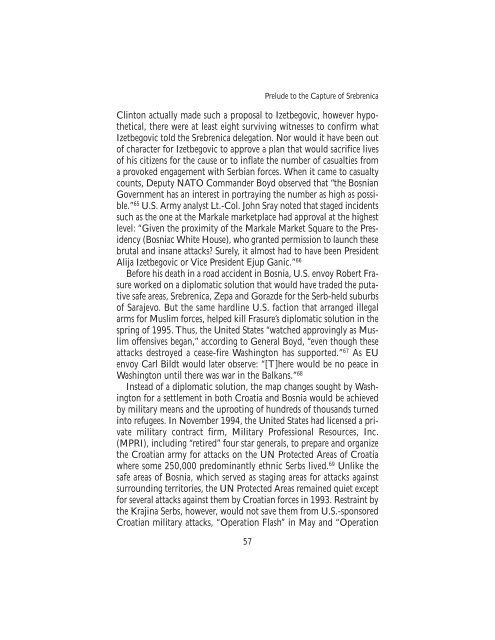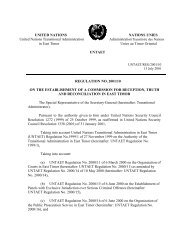The Srebrenica Massacre - Nova Srpska Politicka Misao
The Srebrenica Massacre - Nova Srpska Politicka Misao
The Srebrenica Massacre - Nova Srpska Politicka Misao
Create successful ePaper yourself
Turn your PDF publications into a flip-book with our unique Google optimized e-Paper software.
Prelude to the Capture of <strong>Srebrenica</strong><br />
Clinton actually made such a proposal to Izetbegovic, however hypothetical,<br />
there were at least eight surviving witnesses to confirm what<br />
Izetbegovic told the <strong>Srebrenica</strong> delegation. Nor would it have been out<br />
of character for Izetbegovic to approve a plan that would sacrifice lives<br />
of his citizens for the cause or to inflate the number of casualties from<br />
a provoked engagement with Serbian forces. When it came to casualty<br />
counts, Deputy NATO Commander Boyd observed that “the Bosnian<br />
Government has an interest in portraying the number as high as possible.”<br />
65 U.S. Army analyst Lt.-Col. John Sray noted that staged incidents<br />
such as the one at the Markale marketplace had approval at the highest<br />
level: “Given the proximity of the Markale Market Square to the Presidency<br />
(Bosniac White House), who granted permission to launch these<br />
brutal and insane attacks? Surely, it almost had to have been President<br />
Alija Izetbegovic or Vice President Ejup Ganic.” 66<br />
Before his death in a road accident in Bosnia, U.S. envoy Robert Frasure<br />
worked on a diplomatic solution that would have traded the putative<br />
safe areas, <strong>Srebrenica</strong>, Zepa and Gorazde for the Serb-held suburbs<br />
of Sarajevo. But the same hardline U.S. faction that arranged illegal<br />
arms for Muslim forces, helped kill Frasure’s diplomatic solution in the<br />
spring of 1995. Thus, the United States “watched approvingly as Muslim<br />
offensives began,” according to General Boyd, “even though these<br />
attacks destroyed a cease-fire Washington has supported.” 67 As EU<br />
envoy Carl Bildt would later observe: “[T]here would be no peace in<br />
Washington until there was war in the Balkans.” 68<br />
Instead of a diplomatic solution, the map changes sought by Washington<br />
for a settlement in both Croatia and Bosnia would be achieved<br />
by military means and the uprooting of hundreds of thousands turned<br />
into refugees. In November 1994, the United States had licensed a private<br />
military contract firm, Military Professional Resources, Inc.<br />
(MPRI), including “retired” four star generals, to prepare and organize<br />
the Croatian army for attacks on the UN Protected Areas of Croatia<br />
where some 250,000 predominantly ethnic Serbs lived. 69 Unlike the<br />
safe areas of Bosnia, which served as staging areas for attacks against<br />
surrounding territories, the UN Protected Areas remained quiet except<br />
for several attacks against them by Croatian forces in 1993. Restraint by<br />
the Krajina Serbs, however, would not save them from U.S.-sponsored<br />
Croatian military attacks, “Operation Flash” in May and “Operation<br />
57



